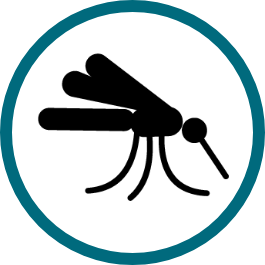Correct and consistent use of ITNs in malarial areas would reduce all-cause child mortality by 20%.1Insecticide-Treated Bed Nets
CDC This is a habitual behavior that needs to be practiced daily.

Insecticide-Treated Net Use
Pregnant women and children sleep under an insecticide-treated net (ITN)
Key Points from Global Research
- In areas with weak distribution systems, making ITNs affordable and regularly available can increase ownership and use.
- Addressing common community perceptions about the health threat posed by malaria and possible actions to mitigate that threat can ensure sustained use of ITNs.
Behavior Profile Sample: Insecticide-Treated Net Use
A Behavior Profile is a summary analysis of each behavior. This sample draws from global evidence and illustrates the result of using the Create Behavior Profiles Tool to analyze factors, supporting actors and strategies and to ensure logical pathways exist between strategies proposed and factors related to the practice of the behavior. This sample may be used as a starting point or reference for creating Behavior Profiles.
| Improve maternal and child survival | |
|
Pregnant women and children sleep under an insecticide-treated net (ITN) Indicator: Percentage of pregnant women who slept under an insecticide-treated net (ITN) the night before the survey
Indicator: Percentage of children under age five who slept under an insecticide-treated net (ITN) the night before the survey |
Behavior Analysis |
Strategy | ||
|---|---|---|---|
STEPSWhat steps are needed to practice this behavior?
Click on any box |
FACTORSWhat factors may prevent or support practice of this behavior? These should be analyzed for each country context.StructuralAccessibility: Stock for universal coverage distribution often differs from true need to cover every sleeping space Accessibility: Populations cannot access ITNs because ITNs are unavailable Accessibility: In areas with weak ITN distribution systems, many cannot afford ITNs SocialNorms: Populations do not sleep under ITNs because malaria is considered normal and unavoidable Norms: Some populations do not sleep under ITNs when there is insufficient supply as they are not prioritized InternalAttitudes and Beliefs: Populations do not sleep under ITNs because they fear possible adverse outcome from insecticides Attitudes and Beliefs: Populations do not sleep under ITNs because ITNs make them hot or uncomfortable, especially during the hot season Knowledge: Populations do not acquire or use ITNs because they do not know when or how to do so Knowledge: Populations do not sleep under ITNs because they do not understand the benefits of using an ITN to prevent malaria |
SUPPORTING ACTORS AND ACTIONSWho must support the practice of this behavior?InstitutionalPolicymakers: Add local requirements for ITNs (i.e. color, length, shape preference, hanging considerations) to the procurement process Providers: Counsel caregivers on the use of ITNs in traditional and non-traditional settings Logistics Personnel: Use available tools (e.g. NetCALC) to ensure sufficient supply of ITNs for mass and continuous distributionr mass and continuous distribution Managers: Couple distribution of ITN with counseling and ongoing monitoring of correct and consistent use, especially in non-permanent sleeping spaces (such as outside, kitchens, etc.) CommunityCommunity and Religious Leaders: Advocate for correct and consistent use of ITNs, especially in non-permanent sleeping spaces (e.g. outside, kitchens, etc.) HouseholdFamily Members: Obtain, hang, and ensure everyone, especially pregnant women and children under five, sleeps under an ITN |
POSSIBLE PROGRAM STRATEGIESHow might we focus our efforts based on this analysis?Enabling EnvironmentFinancing: Monitor and ensure continuous availability of free nets to ensure that the most vulnerable populations have access to ITNs Policies and Governance: Ensure accountability of health care providers, facilities, and system (e.g. availability of commodities, quality of services, adherence to protocols, etc.) to ensure that targeted population has access to ITNs housing and population needs Systems, Products and ServicesProducts and Technology: Procure ITNs based on housing and population needs to ensure that targeted population has access to ITNs Supply Chain: Procure and distribute adequate ITNs for mass campaigns and routine distribution channels including at antenatal care and EPI visits to ensure that the most vulnerable populations have access to ITNs Quality Improvement: Prioritize the importance of proper procurement, distribution and counseling with providers during in-service training, supportive supervision pre-service training Demand and UseAdvocacy : Leverage community data to motivate communities and to create social accountability for ITN use Communication: Employ appropriate SBCC activities to reinforce caregivers’ knowledge on the importance, efficacy, and benefits of ITN use Collective Engagement: Engage community members in local ownership of malaria control efforts to ensure community access to ITNs |
Global Status of Accelerator Behavior
Indicator: Percentage of pregnant women who slept under an insecticide-treated net (ITN) the night before the survey
Demographic and Health Survey, Malaria Indicator Survey, The DHS Program Indicator Data API, The Demographic and Health Surveys (DHS) Program
Indicator: Percentage of children under age five who slept under an insecticide-treated net (ITN) the night before the survey
Malaria Indicator Survey, The DHS Program Indicator Data API, The Demographic and Health Surveys (DHS) Program


 The Manoff Group was acquired by JSI in 2022.
The Manoff Group was acquired by JSI in 2022.